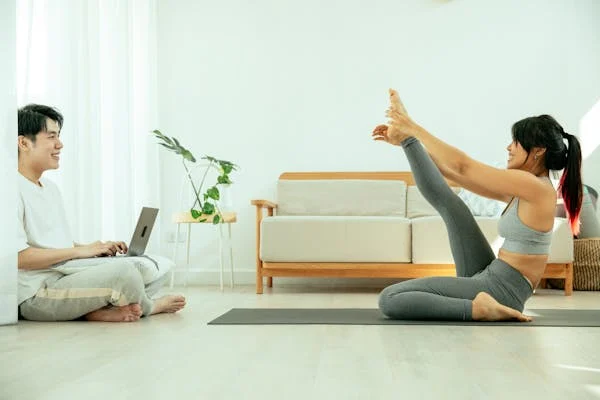Table of Contents
1. Introduction
Uses of Yoga: Derived from the Sanskrit word “Yuj,” yoga means union – the union of body, mind, and spirit. Traditionally, yoga was practiced as a means of attaining spiritual enlightenment, but over time, it has gained recognition for its numerous health benefits.
In today’s fast-paced world, yoga has become a sanctuary for many seeking physical fitness, mental clarity, and emotional balance. Whether you are a beginner or an experienced practitioner, yoga offers countless benefits tailored to your needs.
In this article, we will dive into the top 10 uses of yoga, showing how it can have a positive impact on every aspect of your life.

2. Use 1: Improves Physical Fitness
While perhaps one of the most obvious benefits of yoga is its contribution to overall physical fitness, it differs from intense workouts through controlled movements that enhance strength, flexibility, and balance.
Strength Training: Yoga teaches individuals muscle strength through persistent poses, such as Warrior Pose and Plank Pose. Such poses require muscle groups to work in unison, building endurance and stability.
Flexibility: Downward Dog and Triangle Pose loosen muscle tightness, encourage joint mobility, and improve posture.
Balance: Yoga improves coordination and balance with poses like Tree Pose, which demand attention and engagement of the core.
Yoga is a perfect accompaniment to other workout programs, and therefore, anyone can practice yoga.
3. Use 2: Reduces Stress and Anxiety
Yoga is famous for its de-stressing ability. The gentle movement, meditation, and mindful breathing all calm the nervous system and reduce the physiological and psychological stress effects.
Pranayama (Breathing Techniques): Pranayama exercises, such as Alternate Nostril Breathing (Nadi Shodhana), lead to relaxation and reduction of cortisol, the stress hormone.
Restorative Poses: Child’s Pose and Seated Forward Bend relax the body completely, which removes anxiety.
Mindfulness: Yoga practice brings about the consciousness of the present moment and reduces the thinking about the past or future.
Yoga practice leads to inner peace, which can be used in daily life as a stressor management tool.


4. Use 3: Improves Mental Acuity and Concentration
Yoga’s concept of mindfulness does not only quiet the mind but also sharpens mental acuity and concentration. As movement is synchronized with breath, it enhances cognitive functions and reduces mental fatigue.
Increased Focus: Meditative practices in yoga enhance attention and improve decision-making capabilities.
Enhanced Creativity: A calm mind is more creative, and yoga activates the brain’s ability to solve problems.
Mental Strength: Yoga helps to remove mental clutter, thus making thoughts clearer and enhancing memory.
These reasons make yoga perfect for students, workers, and everyone who wants to enhance their mental capabilities.
5. Use 4: Helps Heart Health
It has been shown to be helpful for the cardiovascular system in improving blood circulation, lowering blood pressure, and reducing stress levels.
Regulation of Blood Pressure: Relaxation is enhanced by some of the postures, such as Legs-Up-the-Wall Pose and Bridge Pose, that regulate blood pressure.
Cholesterol: Yoga also helps in lowering the levels of bad cholesterol, thus decreasing the chances of heart diseases.
Stress and Heart Health: Chronic stress is a major precursor to heart conditions, and yoga counters this process.
Yoga can be incorporated into your life as a means of showing support for your heart’s health and longevity.


6. Use 5: Enhances Immune System
Yoga enhances the immune system by decreasing stress, improving circulation, and activating the process of detoxification within the body.
Detoxification: Twisting poses such as Revolved Chair Pose act to stimulate the internal organs so toxins are flushed out.
Lymphatic Drainage: Yoga improves the flow of lymph and this too is used in combating infections.
Reduction in Stress: Stress is known to act as an immunosuppressant, but through yoga, this too is reduced to lead to better health.
A healthier immune system results in fewer diseases and a firmer response to environmental stressors.
7. Use 6: Better Sleep
If you find yourself struggling with insomnia or bad sleeping quality, yoga can solve this condition by relaxing the body and calming your mind.
Relaxing Poses: These include Corpse Pose (Savasana) and Reclined Butterfly Pose, which prepare your body for sleep.
Breathwork: Deep Belly Breathing slows the heart rate, which makes the body sleep.
Mindful Relaxation: Yoga reduces the racing of one’s mind to sleep.
Practicing yoga before bed will improve sleep patterns dramatically, so one can sleep better and have a more restorative night.
8. Use 7: Emotional Well-Being
Yoga develops a sense of body-mind connection that helps in developing self-awareness and emotional balance.
Mind-Body Awareness: Yoga teaches to listen to the body and emotions and develop self-acceptance.
Meditation for Emotional Balance: Guided meditations during yoga help process emotions and develop positivity.
Stress Relief: Lower stress levels lead to a more stable and positive view of life.
Emotional stability leads to better relationships and happiness in life.
9. Use 8: Helps with Weight Management
Yoga is one of the most excellent ways of keeping fit and slim, not just physically but mentally as well.
Calorie Burn: Dynamic yoga such as Vinyasa Flow or Power Yoga increases heart rate and burns calories.
Eating Consciousness: Mindfulness brought through yoga transforms people from emotional eaters into conscious choosers about their food
Balancing hormones in the body which affect a person’s weight through cortisol, for example, and even insulin.
There are two basic ways through which people achieve this holistic path toward weight: yoga takes on physical and psychologic aspects on it.
10. Usage 9 : Ends Chronic Pain
Having chronic pain hinders the full use of some body parts so one needs such kind of comfort through yoga.
Back Pain Relief: Stretches like Cat-Cow Pose and Cobra Pose enhance flexibility of the spine and reduce tension.
Joint Pain Management: Mild styles of yoga, such as Restorative Yoga, can help alleviate pain in conditions like arthritis.
Tension Release: Yoga relaxes tension that has built up in muscles, offering long-term relief.
Since yoga is a non-invasive practice, it is an excellent addition to traditional pain management strategies.


11. Use 10: Improves Respiratory Health
Breathing is one of the core elements of yoga, and it directly impacts lung health and overall respiratory function.
Increased Lung Capacity: Pranayama exercises increase oxygen intake and lung efficiency.
Asthma Relief: Yoga reduces the severity of asthma symptoms by strengthening the respiratory system.
Breath Awareness: Techniques like Alternate Nostril Breathing improve breath control and relaxation.
Yoga’s focus on breathing not only enhances respiratory health but also promotes a sense of calm and vitality.
12. How to Make Yoga a Part of Your Daily Life
Attuning yoga with daily life is not that difficult. Whether you are a beginner or a veteran, here are some practical tips to make sure that yoga becomes part of your daily schedule:
1. Begin Small
Start from short sessions of 10-15 minutes daily. Short sessions may include simple postures like Child’s Pose, Cat-Cow, or even basic breathing exercises.
Gradually increase the duration and intensity as you build your confidence and stamina.
2. Designate a Dedicated Space
Designate a quiet, comfortable area for your practice. Use a yoga mat and, if necessary, props like blocks and straps to assist in poses.
A clutter-free space helps maintain focus and encourages consistency.
3. Set a Regular Schedule
Choose a time that suits you, such as morning to energize your day or evening to relax before bed.
Make it a non-negotiable part of your daily routine to help you build discipline.
4. Follow a Sequence
Plan a sequence of poses according to your specific needs, be it stress relief, physical fitness, or relaxation.
Apps, online videos, or yoga instructors can guide you through structured routines.
5. Combine Yoga with Meditation
Combine your physical practice with meditation to make the mental and emotional benefits of yoga more significant.
Even sitting in silence for a few minutes, focusing on your breath, can make a huge difference.
13. The Science Behind Yoga’s Benefits
Many studies have been conducted to validate the benefits of yoga. Here are some key findings:
Yoga has been proven to reduce symptoms of depression and anxiety by lowering cortisol levels and increasing serotonin production.
2. Physical Health
Research has indicated that yoga increases flexibility and joint health, lowers blood pressure, and improves cardiovascular health.
3. Brain Function
Yoga has been shown to improve memory, attention span, and general brain function, making it a great tool for cognitive health.
14. Conclusion
Yoga is a transformative practice that offers benefits for the mind, body, and soul. From improving physical fitness and mental clarity to supporting heart health and emotional well-being, the uses of yoga are vast and diverse.
Whether you’re looking to relieve stress, manage chronic pain, or simply improve your quality of life, yoga provides the tools to achieve these goals.
By incorporating yoga into your daily routine, you can unlock its potential to bring balance, health, and happiness into your life. Start your yoga journey today and experience the profound transformation it can bring.
